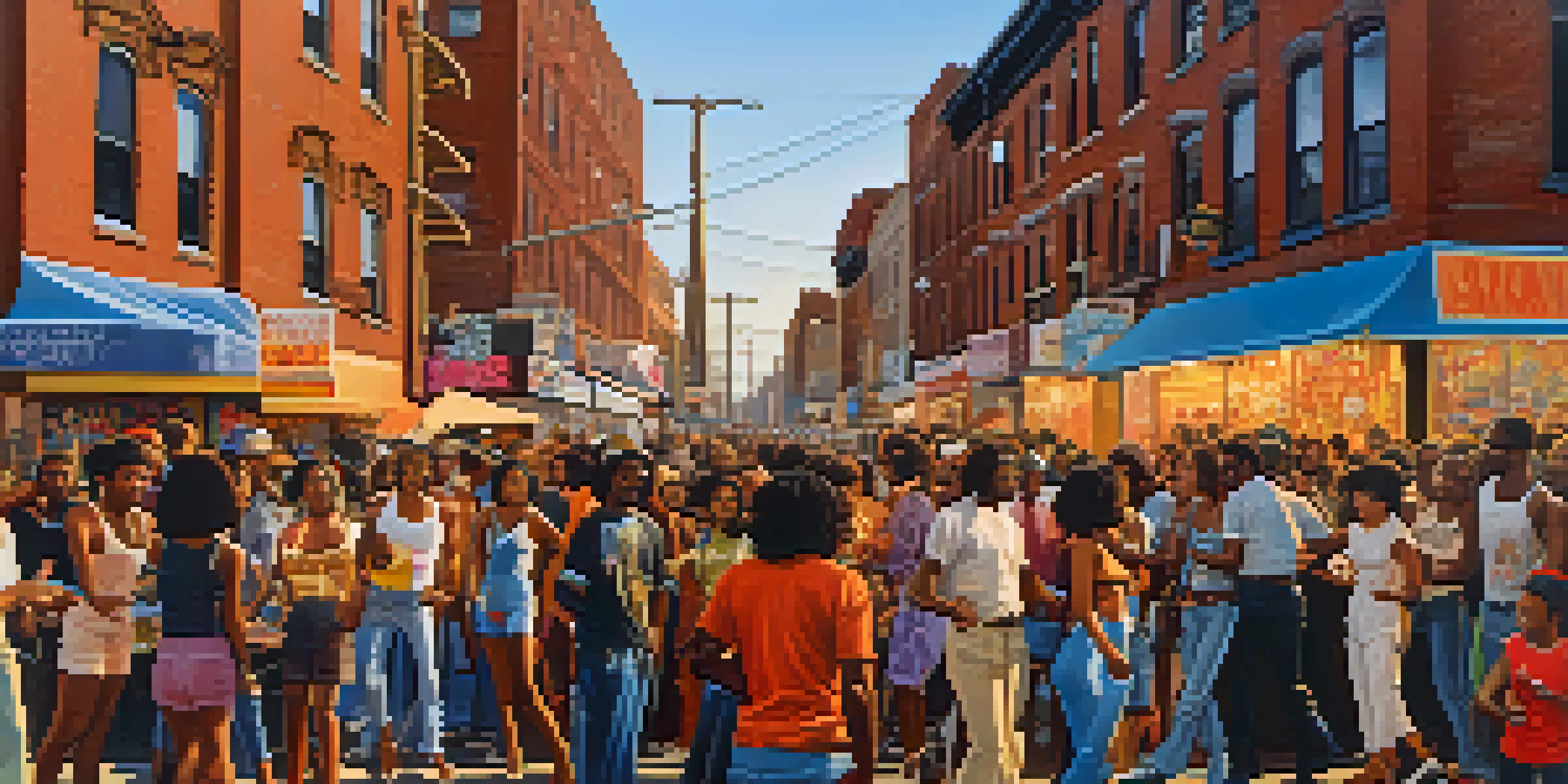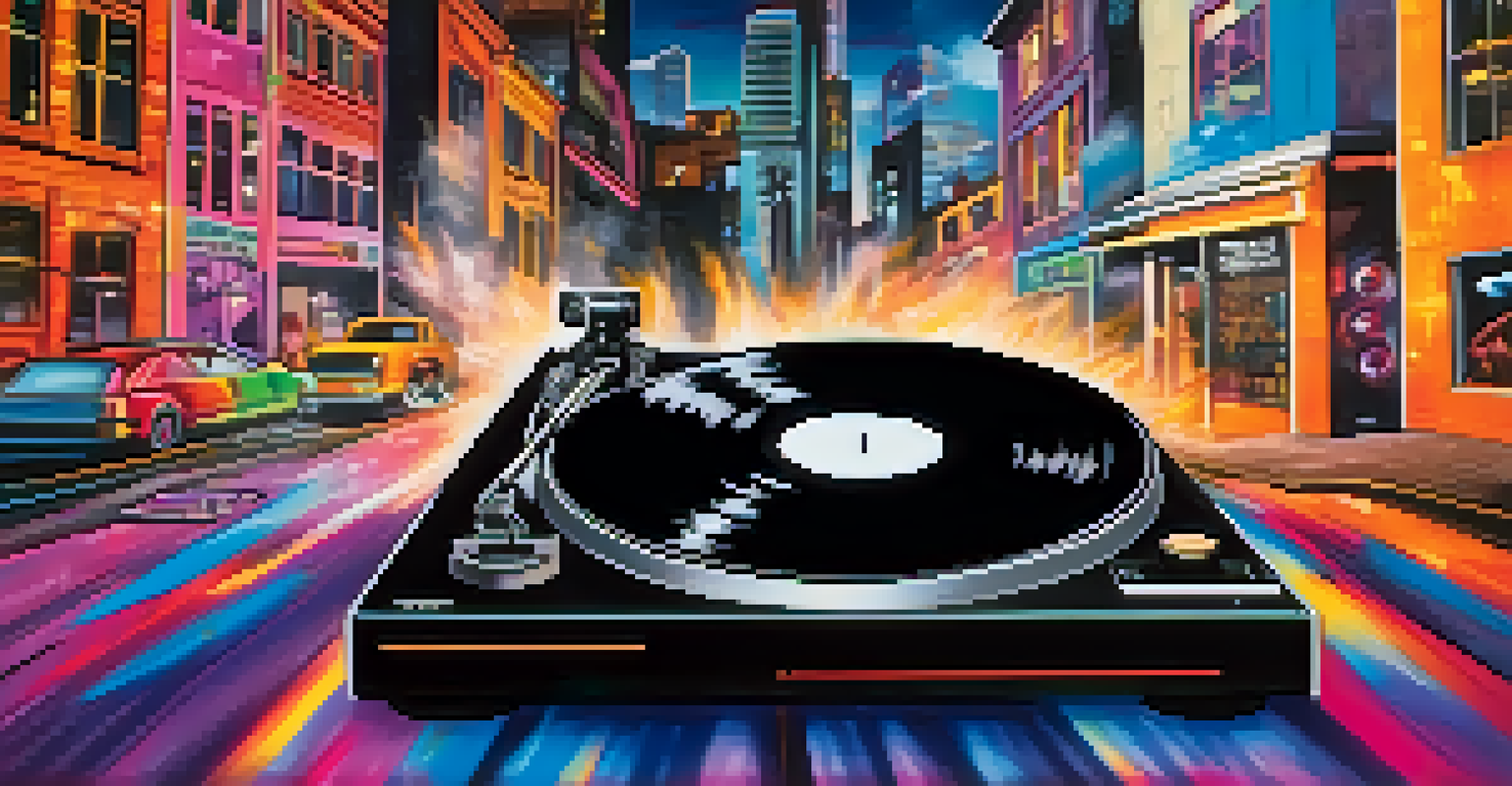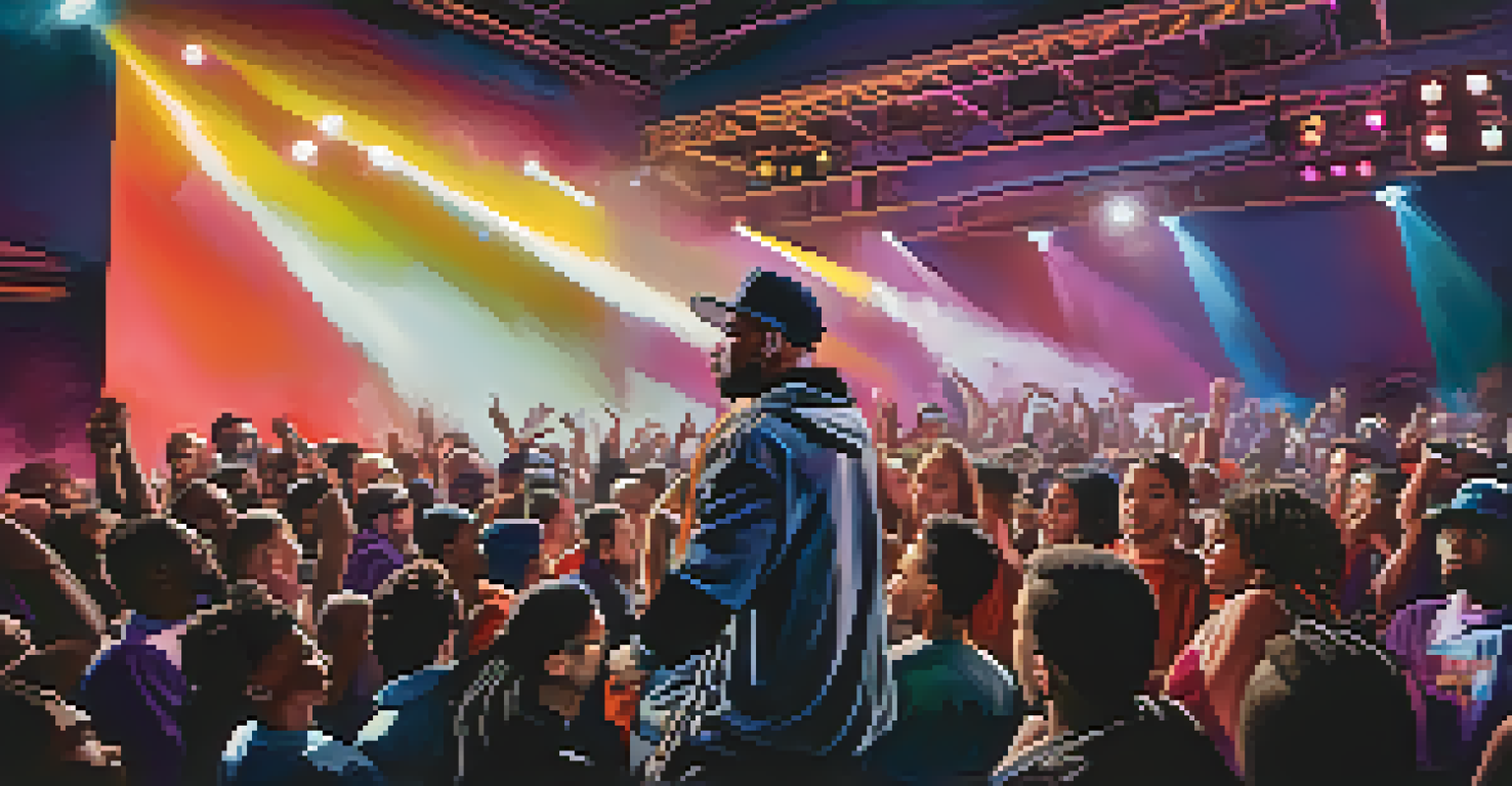The Evolution of Hip-Hop: NYC's Impact on the Genre

The Birth of Hip-Hop: A Cultural Movement in the Bronx
In the late 1970s, the Bronx became the birthplace of hip-hop, a genre that would revolutionize music and culture. DJ Kool Herc, known for his innovative use of turntables, hosted block parties that brought the community together, laying the foundation for hip-hop's rhythmic beats and rhymes. This grassroots movement was not just about music; it was a powerful expression of identity and resilience in the face of adversity.
Hip-hop is a vehicle for social change, a way to express the voices of those who are often unheard.
As DJ Kool Herc spun records, MCs began to engage the crowd with spoken word, giving rise to rapping. This new form of lyrical expression resonated deeply with the youth, who found a voice for their struggles and aspirations. The vibrant energy of these block parties attracted attention, and soon, hip-hop began to gain traction beyond the Bronx, changing the landscape of music forever.
The birth of hip-hop was more than a musical genre; it was a cultural revolution. Elements like breakdancing, graffiti art, and fashion emerged alongside the sound, creating a holistic experience that defined a generation. NYC became the epicenter of this movement, setting the stage for a global phenomenon.
Key Figures: Influencers Who Shaped Hip-Hop's Sound
As hip-hop evolved, several key figures emerged from NYC, each contributing their unique style and perspective to the genre. Artists like Grandmaster Flash and Afrika Bambaataa pushed the boundaries of what hip-hop could be, incorporating diverse musical influences and social commentary into their work. These pioneers not only enriched the sound but also emphasized the genre's roots in community and activism.

Run-D.M.C. brought hip-hop into the mainstream in the 1980s, blending rock and rap, which opened doors for future artists. Their collaboration with Aerosmith on 'Walk This Way' showcased hip-hop's versatility and potential for crossover appeal. This marked a significant moment in music history, as hip-hop began to reach audiences far beyond its origins in the Bronx.
Hip-Hop's Roots in the Bronx
Hip-hop emerged in the late 1970s in the Bronx, driven by community block parties that fostered identity and resilience.
Another influential figure, Nas, emerged in the 1990s with his storytelling prowess and lyrical depth. His album 'Illmatic' is often hailed as one of the greatest hip-hop albums of all time, reflecting the struggles of urban life in NYC. These artists not only shaped the sound of hip-hop but also its identity as a powerful vehicle for social change.
The Golden Age: NYC's Dominance in the Hip-Hop Scene
The late 1980s to the mid-1990s is often referred to as the Golden Age of hip-hop, a time when NYC was at the forefront of the genre's development. During this period, iconic artists like The Notorious B.I.G. and Wu-Tang Clan emerged, each bringing their unique flavor to the scene. Their contributions helped solidify NYC's status as the epicenter of hip-hop culture.
The roots of hip-hop are deep in the community, reflecting the struggles and triumphs of the people.
The Notorious B.I.G., with his smooth flow and vivid storytelling, captured the struggles and triumphs of street life in Brooklyn. His debut album, 'Ready to Die,' became a defining work of the era and showcased the raw, authentic nature of hip-hop. Meanwhile, Wu-Tang Clan introduced a gritty, martial arts-inspired aesthetic that resonated with fans and influenced countless artists.
This Golden Age was characterized by innovation and experimentation, with artists blending genres and pushing lyrical boundaries. NYC's influence was evident as hip-hop began to permeate mainstream culture, with music videos, fashion, and dance styles gaining popularity worldwide. This era laid the groundwork for the global hip-hop movement we see today.
The Rise of Regional Styles: Hip-Hop Beyond NYC
As hip-hop's popularity surged, artists from other regions began to carve out their own identities, leading to the emergence of distinct regional styles. The West Coast, with its laid-back vibe and G-funk sound, produced iconic figures like Snoop Dogg and Dr. Dre, who brought a different flavor to the genre. This diversification illustrated hip-hop's adaptability and its ability to reflect the cultural nuances of different communities.
Meanwhile, the South introduced a unique sound characterized by heavy bass and catchy hooks, with artists like OutKast and Lil Wayne leading the charge. Their innovative approaches challenged the traditional NYC-centric view of hip-hop and showcased the genre's evolution into a multifaceted cultural force. This regional expansion broadened hip-hop's appeal and created a rich tapestry of sounds and styles.
Key Influencers Shaping Hip-Hop
Pioneering artists like Grandmaster Flash and Nas significantly enriched hip-hop's sound and cultural impact, bridging music with social commentary.
Despite the rise of regional styles, NYC remained a significant influence. Artists from different areas often collaborated with NYC legends, bridging the gap and creating a sense of unity within the hip-hop community. This interconnectedness not only enriched the genre but also highlighted hip-hop's roots as a movement that celebrates diversity and shared experiences.
The Role of Technology: Shaping Hip-Hop's Future
With the advent of technology, hip-hop has experienced a significant transformation. Digital platforms like SoundCloud and social media have democratized music production, allowing aspiring artists to share their work without traditional gatekeepers. This shift has led to a surge of creativity and diversity within the genre, as new voices emerge from every corner of the globe.
Moreover, technology has influenced the way music is created and consumed. Sampling, once a hallmark of hip-hop, has evolved with advanced software, enabling artists to experiment with sounds and styles like never before. As a result, hip-hop has become an ever-evolving genre that continues to push boundaries and redefine itself.
However, this technological shift also presents challenges, such as the saturation of the market and the struggle for artists to stand out. Yet, NYC remains a hub for innovation, with its rich history serving as a foundation for the next generation of hip-hop artists. The city's ability to adapt and embrace change ensures that it will continue to play a pivotal role in shaping the future of the genre.
Globalization of Hip-Hop: NYC's Influence Worldwide
As hip-hop spread across the globe, NYC's influence remained a driving force in the genre's evolution. International artists began to adopt hip-hop's elements, infusing their local cultures and languages into the music. This fusion created a rich tapestry of sounds, showcasing the genre's ability to transcend borders and resonate with diverse audiences.
Countries like France, Japan, and Brazil have developed their own unique hip-hop scenes, often inspired by the foundational elements established in NYC. For instance, French hip-hop artists like IAM and NTM brought a politically charged narrative to their music, echoing the social commentary found in classic NYC tracks. This cross-pollination of styles has enriched the global hip-hop landscape.
Global Expansion of Hip-Hop Culture
As hip-hop spread worldwide, it absorbed diverse cultural influences while maintaining NYC's legacy as its epicenter.
Despite the geographical distance, NYC remains a cultural touchstone for many artists worldwide. The city's iconic landmarks, such as the Apollo Theater and Brooklyn's streets, have become symbols of hip-hop heritage. As the genre continues to evolve, NYC's legacy as the birthplace of hip-hop ensures its ongoing relevance on the global stage.
The Future of Hip-Hop: NYC's Ongoing Influence
Looking ahead, the future of hip-hop is bright, with NYC continuing to play a vital role in shaping the genre. Emerging artists are redefining hip-hop through innovative sounds and fresh perspectives, often drawing inspiration from the city's rich musical history. This blend of tradition and innovation ensures that hip-hop will remain a dynamic and relevant force in the music industry.
Moreover, as societal issues continue to evolve, hip-hop will likely serve as a platform for expressing the voices of marginalized communities. Artists will harness the genre's power to address important topics like social justice, mental health, and identity, ensuring that hip-hop remains a vehicle for change. NYC's rich tapestry of cultures will undoubtedly influence these narratives.

In conclusion, the evolution of hip-hop is a testament to its resilience and adaptability. With NYC at its core, the genre has transformed from a local movement into a global phenomenon, influencing and inspiring generations. As we look to the future, the spirit of hip-hop, rooted in the streets of New York, will continue to thrive, evolve, and inspire.